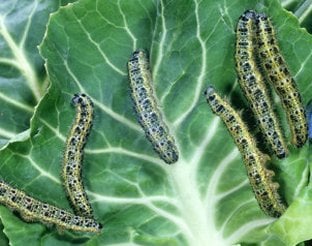CABBAGE WHITE BUTTERFLY
SYMPTOMS: Holes in leaves, generally poor plant health, the presence of caterpillars similar to those shown below or pale green coloured. The caterpillars will be most commonly seen in May and then June to August.
TREATMENT: For complete details on how to treat the Cabbage White Butterfly click here.
CABBAGE WHITEFLY
SYMPTOMS: The defining symptom of Cabbage Whitefly is the white cloud that arises when the leaves are disturbed. If you look at the underside of the leaves closely small white larvae will be present.
The larvae also exude a sticky substance which attracts infections turning it to sooty black coating. This stage is serious because it will weaken the plant significantly and attract other diseases.
TREATMENT: Natural sprays containing Pyrethrum cab be effective but several applications will be necessary. For more severe case something like Bayer Provado Ultimate Fruit and Vegetable Bug Killer can be used but follow the instructions carefully.
As for non-chemical treatments, none have been proven to work. One I have heard of which will clearly work is to purchase a hand held car vacuum. Use the vacuum over the plant, paying special attention to the undersides. This definitely sucks up many of these pests but is not a total solution.
Garlic spray is one suggested solution as is attracting the natural enemy of whitefly, ladybirds and lacewings. Picking off or squashing individual whitefly is a pointless task with curly kale, there are just so many surfaces for the bugs to hide in.
CLUB ROOT
SYMPTOMS: The first signs you will have are plants that look wilted in warm weather, the leaves may have a bluish tinge to them. Typical of this disease is that the plant recovers over night and may look OK in the morning only to wilt later on. The roots will be enlarged and distorted.
TREATMENT: For complete details on how to treat Club Root click here.
CABBAGE ROOT FLY
The flies of this pest don’t damage the plant, it is the little white larvae which are the problem.
SYMPTOMS OF CABBAGE ROOT FLY: The plants will grow poorly and quickly begin to wilt. This is because the larvae are eating the roots and the kale plant is unable to absorb sufficient water. When the plants are dug up the earth around and on the roots will have little white larvae in them.
Young plants are far more affected compared to mature plants.
TREATMENT OF CABBAGE ROOT FLY: There is no chemical treatment available to amateur gardeners in the UK. Non-chemical treatment consists of:
- Placing cabbage collars around the stems of kale when they are planted out or first emerge as seedlings. The collars are available for garden centres and online (try Suttons here) or can be homemade from cardboard, felt or similar. Any eggs laid on the collar by the cabbage fly will simply dry up and die.
A Cabbage Collar
- Cover the young plants with horticultural fleece or insect mesh netting. This prevents the flies getting anywhere near your kale plants.
Cabbage Root Fly normally has three generations each year, during April to September) but it is the first generation which cause the major problems. So the mesh netting can be erected when the kale is transplanted or the seedlings appear. It can then, in most cases, be removed in late June.
- Nematodes can be watered onto the soil to destroy any larvae. These are also available from garden centres and online (try Suttons here). Be sure to follow the pack instructions exactly for best results. Two doses may well be required for complete protection.


Best Conditions for Growing Kale
When and How to Sow Kale Seeds
Care Plan
When and How To Harvest Kale
Differences in Growing Rape Kale
Recommended Varieties of Kale
Pests and Disease
KALE PESTS AND DISEASES
We list below all the common pests and diseases which may affect kale.